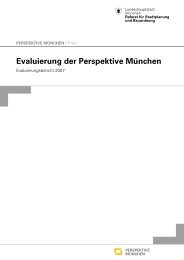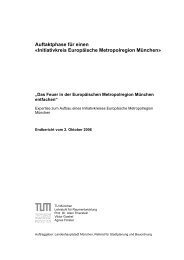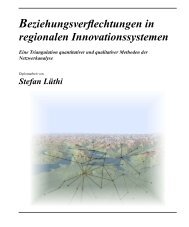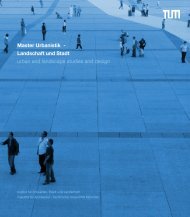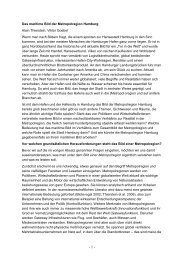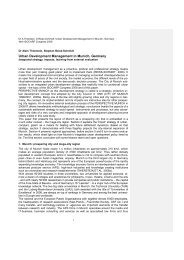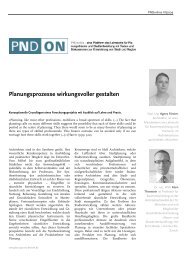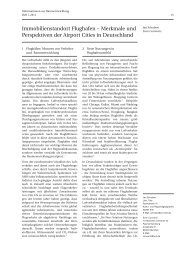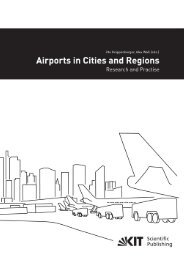0.6-1-Cover and Table of Contents-pp 0-05.indd - Raumentwicklung ...
0.6-1-Cover and Table of Contents-pp 0-05.indd - Raumentwicklung ...
0.6-1-Cover and Table of Contents-pp 0-05.indd - Raumentwicklung ...
You also want an ePaper? Increase the reach of your titles
YUMPU automatically turns print PDFs into web optimized ePapers that Google loves.
The Role <strong>of</strong> the Design Studio in Shaping an Architectural Education for Sustainable Development:<br />
The Case <strong>of</strong> Beirut Arab University<br />
KHALID S. AL-HAGLA<br />
the design studio as the backbone for the<br />
architectural education. The weight <strong>and</strong> time<br />
it takes reflects its importance. However, it<br />
takes up about 27.8% (5/18) <strong>of</strong> the total credit<br />
hours studied each term <strong>and</strong> about 35.7%<br />
(10/28) <strong>of</strong> all teaching hours. The importance<br />
the design studio has is consistent along the<br />
five levels <strong>of</strong> the study - two modules in each<br />
level, <strong>and</strong> succeeding in each <strong>of</strong> these levels<br />
is a prerequisite to move to the higher one. This<br />
guarantees attaining the needed cumulative<br />
knowledge while upgrading through these<br />
levels. The first level - in both <strong>of</strong> its two modules,<br />
the first <strong>and</strong> second term - is directed towards the<br />
study <strong>of</strong> the architectural design fundamentals.<br />
Starting from the second level, the studiobased<br />
design education places an emphasis<br />
on analysis, research <strong>and</strong> experimentation as<br />
an important part <strong>of</strong> the design process, which<br />
pave the way to coming to a proper design. At<br />
this level, the design studio represents a basis<br />
for the underst<strong>and</strong>ing <strong>of</strong> architectural design<br />
as a response to the increasing complexity<br />
<strong>of</strong> ethical, social, conceptual <strong>and</strong> formal<br />
conditions, such as sustainability, identity,<br />
cultural imperatives, <strong>and</strong> modes <strong>of</strong> realizing<br />
architectural designs. Students are asked to<br />
make designs in response to specific aims<br />
including modular design, architectural space<br />
grouping, articulation <strong>of</strong> space <strong>and</strong> functional<br />
relationships. In the second module <strong>of</strong> this level,<br />
the design studio draws a number <strong>of</strong> constraints<br />
as a problem-based study a<strong>pp</strong>roach regarding<br />
the building <strong>and</strong> site relationship, environmental<br />
aspects <strong>and</strong> site planning. The third level builds<br />
upon the previous two levels. The students<br />
are asked to develop design projects based<br />
on the disciplinary or interdisciplinary theme<br />
<strong>of</strong> the design studio. Detailed knowledge<br />
<strong>of</strong> a specialist or interdisciplinary aspect <strong>of</strong><br />
design is required, as are its oral <strong>and</strong> graphic<br />
presentation <strong>and</strong> demonstration. In addition,<br />
a set <strong>of</strong> aims are to be fulfilled regarding the<br />
process <strong>of</strong> site analysis, space organization<br />
(interior <strong>and</strong> exterior), structural systems, forms,<br />
the advanced study <strong>of</strong> building context, the<br />
development <strong>and</strong> creation <strong>of</strong> architectural<br />
character <strong>and</strong> identity in the design <strong>of</strong> spaces<br />
<strong>and</strong> buildings. The fourth level comprises the<br />
study <strong>of</strong> more complicated patterns <strong>of</strong> space,<br />
form, functional relationships, <strong>and</strong> circulation.<br />
In its second module, the design studiobased<br />
study draws a more comprehensive<br />
a<strong>pp</strong>roach, as it links all the physical, social<br />
<strong>and</strong> economic aspects <strong>of</strong> more complicated<br />
projects. In addition, l<strong>and</strong> use, circulation,<br />
densities, <strong>and</strong> structural systems are deeply<br />
studied. The fifth level emphasizes design studio<br />
topics requiring theoretically informed <strong>and</strong><br />
viable architectural solutions. The studio work is<br />
coupled with extensive analysis, research <strong>and</strong><br />
experimentation. In addition, it focuses on giving<br />
general training to h<strong>and</strong>le large architectural<br />
problems with special emphasis on all the<br />
pr<strong>of</strong>essional <strong>and</strong> technical problems through<br />
research work, the formulation <strong>of</strong> concepts,<br />
<strong>and</strong> design processes. The graduation project<br />
represents the second module <strong>of</strong> this level. It<br />
encompasses a comprehensive design project<br />
that shows the formulation <strong>of</strong> all the previously<br />
studied skills.<br />
The previously addressed studio-based levels<br />
for design education show that embedding<br />
sustainability underst<strong>and</strong>ings, concepts, a<strong>pp</strong>lications,<br />
<strong>and</strong> methods is not placed at the heart <strong>of</strong> the<br />
curriculum’s objectives. However, the importance<br />
given to some related concepts along the five levels<br />
draws the main contributors to promote sustainability<br />
foundations during the study. In addition, the<br />
Archnet-IJAR, International Journal <strong>of</strong> Architectural Research - Volume 6 - Issue 1 - March 2012<br />
31



